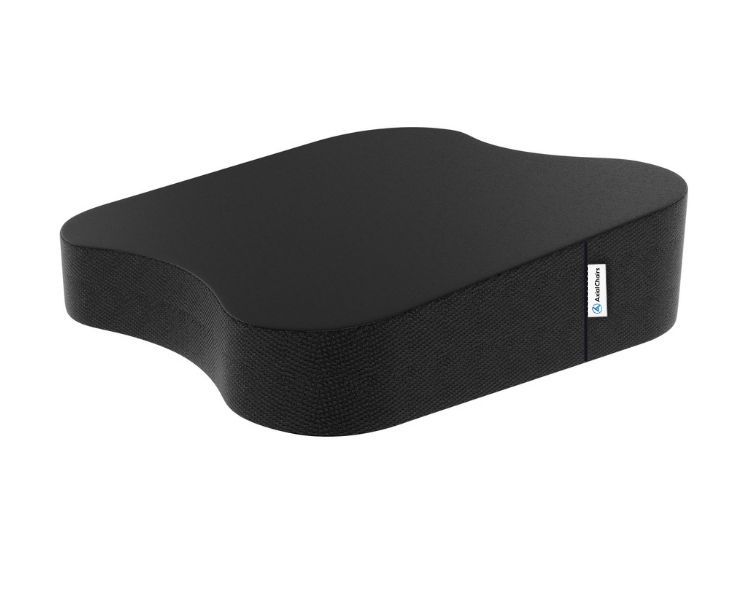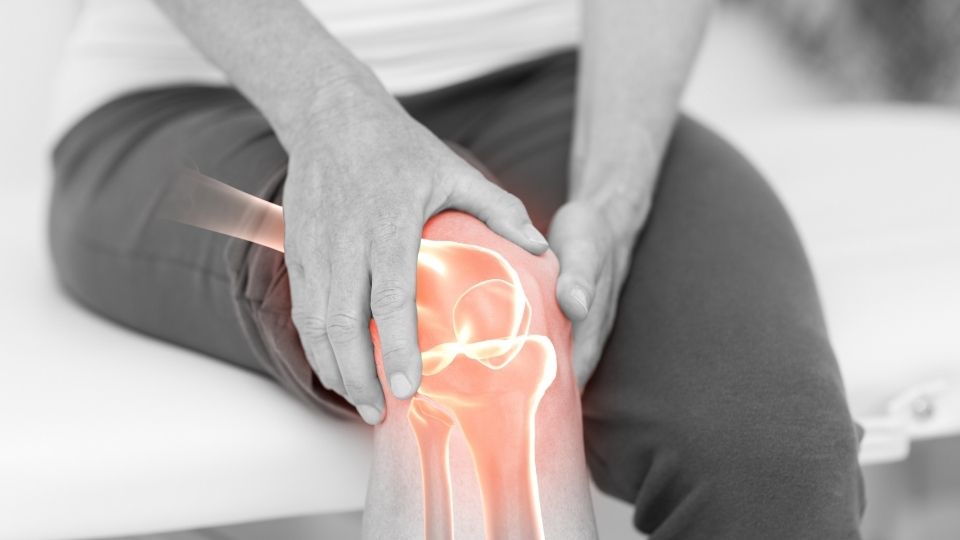Are your knees aching after sitting too long? You’re not alone. Many people experience knee discomfort due to chronic issues or simply sitting in an unergonomic position for extended periods of time. Fortunately, there is something you can do to make your seat more comfortable so you don’t have to suffer any longer! In this blog post, we’re going to offer up advice from the perspective of a healthcare professional on how to sit without hurting your knees and finding comfort while seated.
As a general rule, Sitting for extended periods can lead to knee pain, but using an ergonomic seat cushion with natural latex may alleviate discomfort. The cushion’s 8 to 11 degree tilt promotes proper spinal alignment and takes pressure off the knees. This simple solution can improve posture and prevent future joint pain.
10 Best Tips to Avoid Knee Pain while Seated
Mind your posture
First and foremost, posture plays a significant role in how your body feels while sitting. Slouching or hunching over can lead to misalignments in your spine, causing strain on your knees. To maintain proper spinal alignment, sit with your back straight and shoulders pulled back. Your feet should be flat on the floor, with your knees forming a greater than 90-degree angle. This position helps distribute your weight evenly and takes the pressure off your knees.
Engage your core
A balanced and strong core is essential for maintaining proper spinal alignment and preventing knee pain. Your core muscles work together to stabilize your spine, pelvis, and hips, which in turn reduces the strain on your knees. Practice engaging your core while sitting by lightly drawing your belly button in toward your spine. This small action can make a significant difference in keeping your spine stable and your knees pain-free.
Choose the Best Seat Cushion
To effectively address your seating needs, it’s crucial to pay attention to multiple aspects, including chair modification as a vital component. Various techniques can be employed to achieve this, such as adding a specialized seat cushion and lumbar support. These features can ease pressure on your back and legs, increasing comfort and maintaining proper posture during extended sitting sessions. Also, confirm that your feet are flat on the floor and that there is ample room between your chair and desk. By implementing these recommendations, any basic firm chair can be upgraded into an ergonomic oasis that fosters long-lasting health and well-being.
Ergonomic Seating Solution
An ergonomic seat wedge (pictured above) can be used to properly align your spine and foster better balance. This expertly crafted natural latex cushion contributes to developing core muscles while relieving tension in other areas, such as the neck and shoulders. Additionally, sitting upright is less taxing on your hips and knees, as it involves more muscle groups at once compared to reclining on a plush surface. This vertical posture helps avoid strain-inducing habits that people may inadvertently adopt while working.
All Day Comfort & Support
Use a footrest
If your chair isn’t adjustable or if you’re unable to maintain the ideal knee angle, consider using a footrest. A footrest can help elevate your feet, allowing you to maintain the proper knee position and take the pressure off your knees.
I’ve written a complete hands-on review about the best sitting position for sciatica, and here is what I tested best with my sciatica patients.
Take breaks and stretch
Sitting for long periods can cause your muscles to tighten and become fatigued, which can lead to knee pain. Make sure to take breaks and stand up every 20-30 minutes to stretch your legs and give your knees a break. Try stretching your hamstrings, quadriceps, and calves to keep your muscles loose and flexible.
Strengthen your leg muscles

Strong leg muscles can help support your knees and reduce the risk of pain. Incorporate leg-strengthening exercises, such as squats, lunges, and leg presses, into your fitness routine to build the necessary strength and stability around your knees.
Maintaining proper spinal alignment and having a balanced and strong core are key components of sitting without causing knee pain. Be mindful of your posture, engage your core, choose the right chair, use a footrest if needed, take breaks to stretch, and work on strengthening your leg muscles. With these tips in mind, you’ll be well on your way to sitting comfortably and pain-free!
Adjust your workspace
Ergonomics play a crucial role in maintaining proper posture and preventing knee pain. To create an ergonomic workspace, ensure that your computer monitor is at eye level, so you don’t have to hunch over or strain your neck. Your keyboard and mouse should be positioned in a way that allows your elbows to form a 90-degree angle. By optimizing your workspace, you can maintain proper spinal alignment and reduce the risk of knee pain.
Best Seat Cushion for Knee SupportAxial Ergonomic Seat Cushion® | Seat Chair Wedge
Quick Guide: A 30-Second Summary

All Day Comfort & Support
Product Name
Axial Designs™ Seat Cushion
Price
$149
Warranty
1 Year
Type
Posture Wedge
Top Layer
100% Natural Latex (Molded)
Bottom Layer
High-Density Foam
Top Material
Isometric Grippy Vegan Leather
Bottom Material
Non-Slip Material
Side Material
3D Breathable Fabric
Switch up your sitting position
Sitting in the same position for extended periods can put stress on your knees. Try alternating between different sitting positions, such as crossing your legs or using a footstool to prop up one foot. Changing your sitting position throughout the day can help alleviate pressure on your knees and reduce discomfort.
Consider using a standing desk
In today’s day and age, where most of us are stuck in sedentary jobs that require us to sit for prolonged durations, adopting a healthy lifestyle is of utmost importance. One way to promote an active lifestyle is by incorporating a stand desk into your work setup. A stand desk allows you to work while standing, thereby engaging your muscles and increasing blood circulation throughout the body.
Several studies have shown the benefits of using a stand desk. According to a study published in the International Journal of Behavioral Nutrition and Physical Activity, using a stand desk resulted in an average increase in energy expenditure of 0.7 kcal per minute. Another study published in the Journal of Occupational and Environmental Medicine found that standing while working leads to less fatigue, decreased musculoskeletal discomfort, and improved mood.
Furthermore, using a stand desk helps to reduce the risk of obesity, diabetes, and heart disease. In a six-month study conducted on 24 overweight or obese office workers, the group that used a standing desk experienced an average weight loss of 2.5 kg compared to the control group, which saw no significant weight loss. Similarly, a study published in the American Journal of Epidemiology found that participants who spent more time sitting had a higher likelihood of developing diabetes.
Although the initial cost of a stand desk may be higher, the long-term benefits to your health and productivity make it a worthwhile investment. So, if you’re looking to promote a healthier lifestyle and increase productivity at work, consider using a stand desk.
Listen to your body
Your body knows best when it comes to discomfort and pain. If you find that a specific sitting position or chair is causing knee pain, make adjustments until you find what works best for you. Pay attention to how your body feels and make changes as needed to prevent knee pain and maintain optimal spinal alignment.
Best Sitting Position for Knee Pain | Patellofemoral Pain
If you’re someone who spends long periods sitting down, you might have experienced patellofemoral pain, a common type of knee pain. To alleviate the symptoms and prevent further damage, it’s crucial to pay attention to your sitting position. Avoid crossing your legs or sitting on low chairs, as these positions can aggravate the pain. Instead, opt for a chair with a high backrest that allows you to keep your feet flat on the ground. Furthermore, try to take frequent breaks and walk around the room to keep the blood circulating and avoid stiffness.
How to Relieve Knee Pain From Sitting for Long Periods
Many jobs require sitting in front of a screen for prolonged periods, putting a strain on your joints and leading to knee pain. To counteract this, consider investing in a standing desk that allows you to alternate between sitting and standing positions. Moreover, make sure that your chair supports your lower back and keeps your feet flat on the ground. Finally, don’t forget to stretch your legs and hips during breaks to keep them loose and healthy.
How to Fix Knee Pain From Sitting Cross Legged
Sitting cross-legged might feel comfortable, but it can wreak havoc on your knees, leading to patellofemoral pain and other issues. To fix the problem, start by changing your posture and switching to a seated position that places less pressure on your knees. Additionally, make sure to stretch your quads and hip flexors regularly to keep them limber and flexible. Lastly, if the pain persists, consider consulting with a physical therapist or doctor to rule out any underlying conditions.
Best Resting Position for Knee Pain Health
If you’re dealing with knee pain, it’s essential to find a resting position that relieves the discomfort and speeds up your recovery. One of the best positions is to lie down on your back with a pillow under your knees, which reduces the pressure on your joints and promotes blood flow. Additionally, consider using ice packs or heating pads to relieve inflammation and pain. Remember to take it easy and avoid strenuous activities until your knees have fully healed.
All Day Comfort & Support
Knee Pain When Standing Up From Sitting Position
Getting up from a sitting position might seem like a simple task, but it can be a source of knee pain and discomfort. To avoid this, start by adjusting your sitting position to minimize the pressure on your knees. Additionally, consider investing in a chair that supports your lower back and keeps your feet flat on the ground. Finally, try doing some active sitting exercises to boost your strength and mobility, such as leg lifts and heel raises. With patience and consistency, you can alleviate knee pain and promote overall health.
Summary
Taking care of our health is particularly applicable when it comes to protecting our knees. Taking the right amount of precaution when sitting, can help to ensure that we do not hurt our bodies in the future. Of course every person will have different circumstances and needs, so it’s important to tailor these instructions as best practice for yourself. Additionally, consider adding personalized activities such as walking or practicing yoga at least three times a week. These are great preventative measures and they make sure that you know your body and are taking good care of yourself. Your body should be nourished with positive thoughts and choices so nurture it in a way that reflects your wanting for good physical health. With a caring tone of voice, let’s challenge ourselves to show our bodies the love and kindness they deserve.





